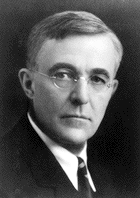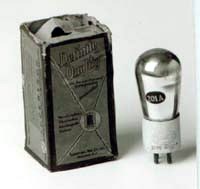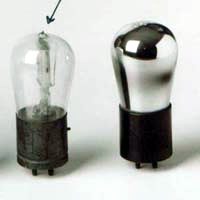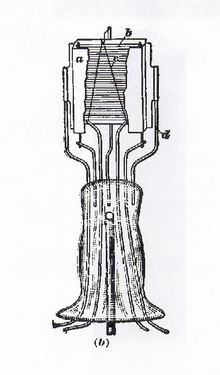|
The first telephonic repeaters were
of electromechanical type and in this way insufficient to
follow the increasing expansion of the telephonic lines.
The engineers had soon noticed they needed a new type of telephonic
repeater that besides acting as
 |
| Irwing Langmuir |
signal amplifier, it should have
also several technical operational and commercial capabilities
such as: - to amplify all the frequency range without distorsion;
durability and quick interchangeability with similar devices,
as well as low manufacturing cost.
However, around 1910, the triode valve was still a simple
thermionic device and in this way, it did not have the necessary
conditions to meet such requirements.
Around 1916, the valve had already suffered enormous technological
modifications either on its structural as well as its operational
concepts. Amongst its main technological advances are:
-Filament or heater: the first type, was the one coated by
oxides whose technique was invented by Wehnelt. Soon followed
the tungsten-thoriated filament, an alloy made of tungsten
and thorium. (a) However, those new types of filaments demanded
the operation in low oxygen atmosphere for the proper electron
emission.
The gettering technique: this deficiency was overcame by the
vaporization or the burnning inside of the glass bulb of active
chemical substances such as magnesium during the final process
of evacuation of the air in such away to remove the small
particles of atmospheric air.
The Getter could still continue active during all the life
of the valve, absorbing small amounts of emitted gaseous particles
from the structural elements of the valve, or even due to
an incompleted rarefaction. (b)
-The structural elements: the first valves used as telephone
repeaters were substantially improved by eliminating its operational
fragility. New materials were used in the manufacturing processes;
this included the base as well as for the valve inner elements
originating an asembling technique as known as Iron Clad.
Through the same the inners, elements were perfectly lined
up and finally mounted inside a glass bulb. (c) -
-The glass bulb: as aforementioned the technology of the valve
manufacturing had its origin in the electric lamp. (d) In
the first valves, the air was removed through superior part
of the bulb and then sealed by a small tip in a pearl shape.
(e) Due to the improvement in the rarefaction processs the
bulb suffered several modifications in its original shape
as well as new type of glasses were used in its manufacturing.
Among them were the lead -carbonates, and the borosilicates
glasses.
In this way, instead of using the primitive blowing process,
the bulb now was moulded in machines or lathes improving the
glass wall thickness. Around 1928 the bulb shapes were already
standardized.
During the First World War, 1914 - 1918, all the operational
conditions of the valve were already known due to the experience
acquired in the manufacturing of the ones used for telephony
applications. Such improvements certainly were extended to
those destined for equipments used for military applications.
Hence the military communication equipments should be built
considering size, rigidity as well as operating in adverse
enviroment conditions, ranging from a freezing radio tent
in the Artic, to a hot destroyer warroom in a in the tropic,
the technological evolution of the thermionics led to the
development of new and reliable types devices such as the
metal valve.
 |
| a) Power triode made in the USA
using filament coated with Oxides. |
|
 |
| (b) The valve type 201, with porcelain
base showing the mirrored bulb due to the gettering
processs; |
|
|
 |
| (e) In the left: valve type 201
with brass base showing the glass bulb where on
its top the air was removed; in the right: same
valve but with a spherical mirrored bulb due to
the gettering. |
|
 |
(c) Early method of assembling the structural elements
where:
A) plate
b) grid
c) filament
|
|